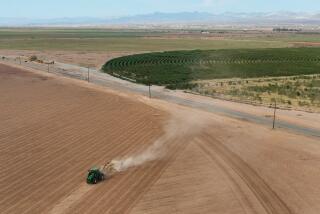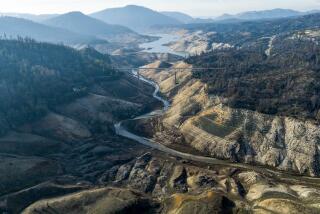Weather Forecast: Wait
Will it be an El Nino? Or an El No Show?
The country’s top weather predictors--scientists at the National Oceanic and Atmospheric Administration--have said since February that an El Nino is on the way. But they can’t say when it will arrive or how strong it will be.
Longer-range experimental forecasts that attempt to predict El Ninos up to one year in advance disagree on what’s ahead. And some of those who closely monitor ocean temperatures say there’s not much to report from the tropical Pacific waters that spawn the global weather phenomenon.
“It’s not happening yet,” said Bill Patzert, an oceanographer at JPL. “It could be an El No Show.”
El Nino is a temporary disruption in the waters of the tropical Pacific and the atmosphere above it that can alter weather patterns around the world. The massive El Nino of 1997-1998 brought torrential rains to California and drought to Indonesia and Australia.
Because of these widespread effects, scientists and government officials are anxious to predict the phenomenon well in advance. Many groups--from energy traders to roofers--await any El Nino news.
Phenomenon Is Linked to Ocean Temperatures
It is about time for an El Nino. They generally occur every three to seven years. But forecasting long-term weather and climate patterns is never an easy game. This year is turning out to be more challenging than usual.
El Ninos are closely linked to ocean temperatures and tropical trade winds.
Warm water generally pools in the western Pacific because trade winds blow from east to west. Every few years, a brief period of weakening trade winds or warming ocean temperatures in the eastern Pacific leads to a yearlong period of warm temperatures in the eastern part of the ocean and weak tropical trade winds.
These interactions, a natural positive feedback loop, crank up to produce an El Nino or its cold, windy cousin, La Nina. Both patterns influence the atmosphere and can disrupt weather around the globe.
The El Nino of 1997-1998 was much easier to get a handle on. Huge pools of warm water quickly spread across the ocean and then warmed the atmosphere. “You saw it coming, then it hit,” said Wayne Higgins, a lead El Nino forecaster at NOAA’s Climate Prediction Center. “This year, the evolution has been really slow. We’re being very cautious.”
Higgins said there was about a 70% chance an El Nino would develop. He was unable to say how weak or strong it might be, but said that it would be unusual to have another strong event after the El Nino of 1997-1998. Major El Nino events occur every two to three decades.
“When you look in the historical record, you don’t find back-to-back El Ninos,” he said.
Nathan Mantua, an atmospheric scientist at the University of Washington who monitors conditions in the tropical Pacific, said he sees what looks like weak El Nino conditions developing.
“I’d be surprised if this cranked up into a major event,” he said. “It might be among the weakest El Ninos we can classify.”
Surges of warm water similar to those seen in 1997-1998 have been reported by South American fishermen, and they have coincided with major changes in coastal fisheries and regional flooding in Peru and Ecuador. But these “coastal El Ninos,” Mantua said, are not always linked to the larger-scale atmospheric changes that yield global El Nino events.
While talk of El Nino often prompts fears of massive floods and houses tumbling down rain-soaked cliffs, the net effect of the wet and warm El Nino generally is considered positive for the United States. Because of lowered winter heating bills in the northern parts of the country and fewer Atlantic hurricanes, the weather pattern results in savings estimated to be billions of dollars and hundreds of lives.
Weak El Nino Could Be Bad News for California
In California, the lack of a strong El Nino may actually be bad news. The state has been drier than average for the last four years, and a weak El Nino is unlikely to change that. “People shouldn’t dis El Nino,” Patzert said. (The current drought on the East Coast is not thought to be linked to El Nino or to the drier La Nina pattern.)
Several groups are trying to predict El Nino events six months to a year in advance, using models of how the oceans and atmosphere behave.
A group at the Scripps Institution of Oceanography is predicting a mild El Nino for the coming winter and next spring, said David Pierce, an analyst at the Climate Research division at Scripps.
But the forecasts of various groups using different ocean and atmosphere models do not agree as well as they did in 1997-1998. “It’s been a little uncertain this year,” Pierce said. “This time around, I guess we’ll find out which models are better.”
Forecasting El Nino remains a challenge. Some aspects of the system--like the slow-moving waves that carry heat across the ocean--can be predicted. But other aspects, like small-scale weather patterns, remain random. “We don’t know how much will ultimately be predictable,” Pierce said.
The fickle trade winds add to the difficulty. When they stop, or reverse, they allow massive shifts in the distribution of warm water in the Pacific. They can change from week to week.
An early indication that an El Nino event may be developing came in January, after the trade winds relaxed for 10 days and allowed waters to warm by 4 degrees to 6 degrees off the South American coast. But the winds soon returned to normal; the water then cooled to just 2 degrees to 4 degrees above normal, NOAA’s Higgins said.
“No one really knows the timing of these big relaxations of trade winds, which really are the key,” said Patzert, who helps monitor the winds at JPL using an orbiting microwave radar called SeaWinds.
NOAA’s Higgins said his group would have a better indication about the current El Nino pattern by May or June, when there are fewer weather vagaries than in spring.
That should still be plenty of warning, since the effects of El Nino on the Northern Hemisphere would not hit until next winter.
“People should just calm down,” Patzert said. “If it does happen, our satellites will definitely give us a heads up and tell us how strong it is.”






